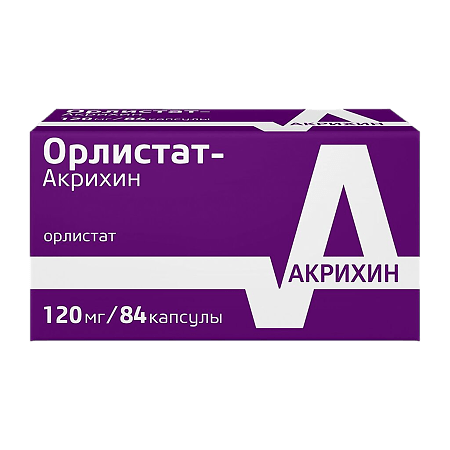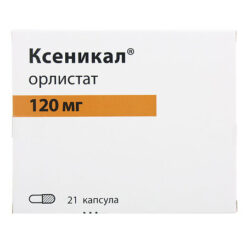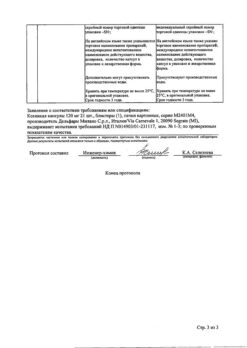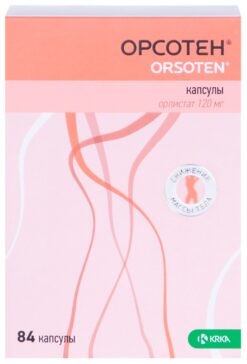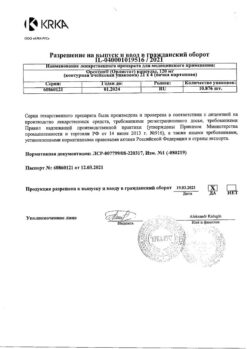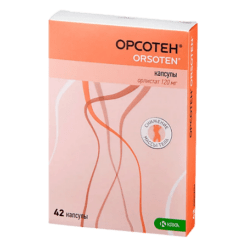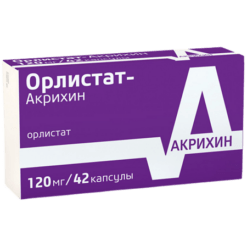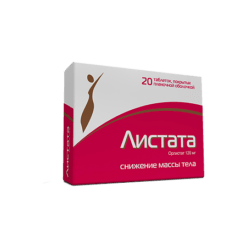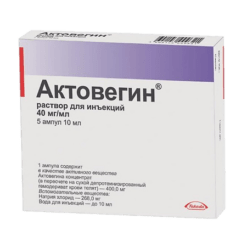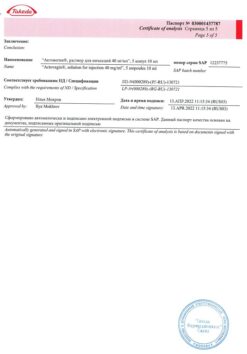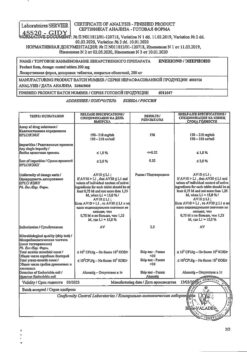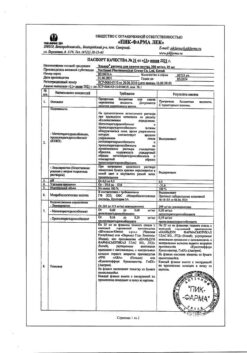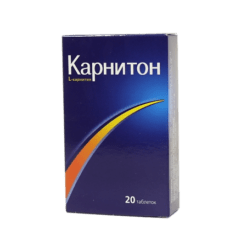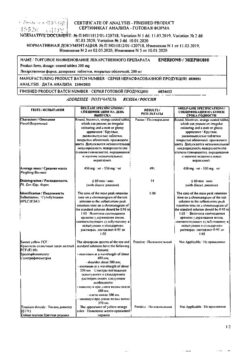No products in the cart.
Orlistat-Acrihin, 120 mg capsules 84 pcs
€91.30 €76.09
Description
Orlistat refers to specific inhibitors of long-acting gastrointestinal lipases. This substance shows its effect in the lumen of the stomach and small intestine by forming a covalent bond with the active serine center of gastric and pancreatic lipases. As a result of the effect of hypolipidemic agent inactivated enzyme loses the ability to break down fats coming with food in the form of triglycerides (TG) to monoglycerides and absorbable free fatty acids.
Since unreplenished TGs are not absorbed from the gastrointestinal tract (GIT), fewer calories are fed into the body and, as a result, body weight is reduced. Thus, the therapeutic effect of the drug is carried out without its absorption into the systemic bloodstream. Due to the activity of orlistat 24-48 hours after oral administration of the drug, the concentration of fat in stools increases.
Leading to a decrease in fat depot, Orlistat-Acrichin provides effective body weight control. In clinical studies involving obese patients, more pronounced weight loss was observed in the group of patients receiving Orlistat compared to patients on diet therapy alone. Weight loss was already observed within the first 2 weeks of starting Orlistat-Acrychin and for 6-12 months thereafter, even if there was a negative response to diet therapy.
Statistically significant significant improvement in the profile of obesity-related metabolic risk factors was recorded for two years. In addition, there was a significant reduction in body fat deposits when compared to the placebo group.
In the group receiving Orlistat, there was a greater reduction in body weight compared with the placebo group, and in addition, a significant improvement in the profile of metabolic risk factors. The new body weight level achieved was maintained for all 4 years of the study. In adolescents with obesity in a 1-year study during treatment with orlistat a decrease in body mass index (BMI) was registered, as well as a decrease in fat deposits and waist and hip circumference compared to the placebo group. Also during the period of taking Orlistat-Acrychin a significant decrease in diastolic blood pressure (BP) was observed in adolescents compared to those who received placebo.
Indications
Indications
Orlistat-Akrikhin is recommended for long-term therapy of obese patients with a BMI ≥ 30 kg/m² or overweight patients with a BMI ≥ 28 kg/m² who have obesity-related risk factors, while undergoing a moderately limited low-calorie diet.
Orlistat-Akrikhin is also indicated for use in patients with type 2 diabetes mellitus with overweight or obesity in combination with a moderately limited hypocaloric diet and/or taking hypoglycemic drugs (insulin and/or sulfonylurea derivatives, metformin).
Pharmacological effect
Pharmacological effect
Orlistat is a long-acting specific inhibitor of gastrointestinal lipases. This substance exerts its effect in the lumen of the stomach and small intestine by forming a covalent bond with the active serine center of gastric and pancreatic lipases. As a result of the influence of a lipid-lowering agent, the inactivated enzyme loses the ability to break down dietary fats in the form of triglycerides (TG) into monoglycerides and absorbed free fatty acids.
Since unsplit TG are not absorbed from the gastrointestinal tract (GIT), fewer calories enter the body, and, as a result, body weight decreases. Thus, the therapeutic effect of the drug is carried out without its absorption into the systemic circulation. Due to the activity of orlistat, 24–48 hours after oral administration of the drug, the concentration of fat in the stool increases.
By reducing fat storage, Orlistat-Akrikhin provides effective control of body weight. In clinical studies involving obese patients, patients receiving orlistat experienced greater weight loss compared to patients receiving diet therapy alone. Weight loss was observed already within the first 2 weeks after starting to take Orlistat-Akrikhin and subsequently for 6-12 months, even in the presence of a negative response to diet therapy.
A statistically significant significant improvement in the profile of obesity-related metabolic risk factors was observed over two years. In addition, there was a significant decrease in fat deposits in the body when compared with the placebo group. Orlistat has also been shown to be effective when used to prevent weight gain. Approximately half of the patients experienced a weight gain of no more than 25% of lost weight, and the other half of the patients in the study did not regain weight or even experienced subsequent weight loss.
In clinical studies that lasted from 6 months to 1 year, overweight or obese patients with type 2 diabetes experienced greater body weight loss when using orlistat compared to patients receiving diet therapy alone. Weight loss occurred mainly as a result of a decrease in the deposition of fat masses in the body. It should be noted that patients enrolled in the study often had poor glycemic control prior to the start of the study, despite taking antidiabetic agents.
A significant improvement in glycemic control was found in these patients when treated with Orlistat. Also, during the use of Orlistat-Akrikhin, a decrease in doses of antidiabetic agents, insulin concentrations, and a decrease in insulin resistance were observed. According to studies that lasted 4 years, it was found that treatment with orlistat significantly reduced the risk of developing type 2 diabetes – by an average of 37% compared to the use of placebo. This threat was reduced by approximately 45% in patients with initial impaired glucose tolerance.
The group receiving Orlistat had a greater reduction in body weight compared to the placebo group, as well as a significant improvement in the profile of metabolic risk factors. The achieved new level of body weight was maintained throughout the 4 years of the study. In obese adolescents in a 1-year study, treatment with orlistat showed a decrease in body mass index (BMI), as well as a decrease in body fat and waist and hip circumference compared to the placebo group. Also, during the period of taking Orlistat-Akrikhin, adolescents experienced a significant decrease in diastolic blood pressure (BP) compared to those receiving placebo.
Special instructions
Special instructions
Orlistat-Akrikhin is recommended for long-term control of body weight (including reducing body weight, maintaining it at the desired level achieved and preventing re-gain of body weight). In patients with type 2 diabetes mellitus, as a result of weight loss when using the drug, the likelihood of improved carbohydrate metabolism increases, which may require a reduction in the dose of hypoglycemic drugs.
Therapy with Orlistat-Akrikhin should not last more than 2 years. If 12 weeks after the start of the course it was not possible to achieve a weight loss of at least 5%, the use of the drug must be stopped. If symptoms such as fatigue, weakness, fever, dark urine and jaundice occur during therapy, you should consult your doctor to rule out possible liver dysfunction.
During treatment with the drug, mainly in patients with concomitant chronic kidney damage and/or dehydration, hyperoxaluria and oxalate nephropathy may develop, which in some cases can lead to renal failure.
Active ingredient
Active ingredient
Orlistat
Composition
Composition
1 capsule contains:
Active ingredient:
orlistat – 120 mg;
Additional components:
sodium carboxymethyl starch,
microcrystalline cellulose,
sodium lauryl sulfate,
colloidal silicon dioxide anhydrous;
Capsule shell:
titanium dioxide (E171),
gelatin,
indigo carmine (E132).
Contraindications
Contraindications
Absolute:
– cholestasis;
– chronic malabsorption syndrome;
– age up to 12 years;
– pregnancy and lactation;
– hypersensitivity to any of the components of Orlistat-Akrikhin.
Particular caution should be exercised when treating with the drug while taking cyclosporine, warfarin or other oral anticoagulants.
Side Effects
Side Effects
Undesirable effects caused by taking orlistat appeared in most cases from the gastrointestinal tract and were associated with the pharmacological effect of the drug, which blocks the absorption of dietary fats.
During the period of taking Orlistat-Akrikhin, the following disorders may occur:
– metabolism and nutritional disorders: very often – hypoglycemia;
– infectious and parasitic lesions: very often – influenza;
– nervous system: very often – headache;
– mental disorders: often – anxiety;
– respiratory system, chest and mediastinal organs: very often – upper respiratory tract infections; often – lower respiratory tract infections;
– genitals and mammary gland: often – irregular menstruation;
– kidneys and urinary tract: often – urinary tract infections;
– Gastrointestinal tract: very often – oily discharge from the rectum, discomfort/pain in the abdomen, release of gases with some discharge, flatulence, loose stools, urgency to defecate, increased frequency of bowel movements, steatorrhea; often – discomfort/pain in the rectum, fecal incontinence, soft stools, bloating, dental damage, gum damage;
– general disorders: often – weakness.
The nature and frequency of side effects in patients with type 2 diabetes mellitus were similar to those in patients without diabetes mellitus who were overweight and obese. During treatment, the frequency of adverse reactions from the gastrointestinal tract increased with an increase in the amount of fat in consumed foods. These disorders can be eliminated or reduced by following a low-fat diet.
In most cases, the above effects were transient and mild, their appearance was noted mainly in the first 3 months of therapy and, as a rule, no more than one episode. With long-term use of Orlistat-Akrikhin, the incidence of these phenomena decreased.
Interaction
Interaction
– amiodarone – a decrease in the level of this substance in the blood plasma may be observed; clinical observation and monitoring of ECG parameters should be carried out;
– antiepileptic drugs – the absorption of these drugs is reduced, which can cause the development of seizures;
– cyclosporine – the level of its content in the blood plasma decreases, which may lead to a weakening of the immunosuppressive effectiveness of the drug; this combination is not recommended; if it is necessary, frequent monitoring of plasma concentrations of cyclosporine is required both during concomitant use of orlistat and after its completion;
– warfarin and other anticoagulants – a decrease in the concentration of prothrombin and an increase in the international normalized ratio (INR) is possible, which can lead to changes in hemostatic parameters; with this combination, monitoring of INR values is necessary;
– fat-soluble vitamins A, D, E, K and beta-carotene – the absorption of these substances is weakened; when used in combination, they must be taken before bedtime or no earlier than 2 hours after taking orlistat;
– acarbose – it is recommended to avoid combined use due to the lack of pharmacokinetic interaction studies;
– levothyroxine sodium – possible development of hypothyroidism and/or decrease in its control due to decreased absorption of levothyroxine sodium and/or inorganic iodine;
– oral contraceptives – the risk of decreased contraceptive action is aggravated, which in some cases increases the likelihood of unplanned pregnancy; you should resort to additional methods of contraception, including if severe diarrhea occurs;
– antiretroviral drugs for the treatment of human immunodeficiency virus (HIV), antipsychotics (including lithium preparations), antidepressants, benzodiazepines – the therapeutic effect of these drugs may be weakened; orlistat therapy in such patients should be started after a thorough assessment of the expected benefits of this treatment and the possible risks;
– fibrates, atorvastatin, digoxin, amitriptyline, biguanides, losartan, pravastatin, fluoxetine, phentermine, sibutramine, nifedipine, phenytoin, ethanol – no interaction was observed with these drugs.
Overdose
Overdose
Cases of drug overdose have not been described.
When taking single (800 mg) and multiple doses (for 15 days up to 400 mg three times a day) orlistat in people with normal body weight/obesity, no adverse effects occurred. When orlistat was taken by obese patients for 6 months at a dose of 240 mg three times a day, no increase in the incidence of adverse reactions was observed.
In case of significant overdose of Orlistat-Akrikhin, the patient should be observed for 24 hours. According to clinical and preclinical studies, systemic effects associated with the lipase inhibitory properties of orlistat should be quickly reversible.
Recommendations for use
Recommendations for use
Orlistat-Akrikhin is used orally with each main meal (during meals, immediately before meals or no later than 1 hour after meals). Capsules should be taken with water.
For long-term therapy, obese patients (BMI ≥ 30 kg/m²) or overweight individuals (BMI ≥ 28 kg/m²) with obesity-related risk factors aged 12 years and older, while following a moderately limited low-calorie diet, should take Orlistat-Akrikhin at a dose of 120 mg orlistat (1 capsule) 3 times a day.
When prescribing the drug to adult patients with type 2 diabetes mellitus who are obese or overweight with concomitant use of hypoglycemic agents and/or following a moderately limited hypocaloric diet, it is recommended to take 120 mg of orlistat (1 capsule) 3 times a day. It is allowed to skip the next capsule intake if the food does not contain fat or the meal was skipped.
During the period of therapy, it is required to adhere to a balanced, moderately limited hypocaloric diet containing no more than 30% of calories in the form of fat; it is also recommended to include fruits and vegetables in the daily diet. The total amount of carbohydrates, fats and proteins consumed per day must be divided into three main meals. When using orlistat in doses exceeding 3 capsules per day, no increase in the therapeutic effect was observed.
A study of the safety and effectiveness of taking Orlistat-Akrikhin in patients with functional disorders of the liver and/or kidneys has not been conducted.
Functional features
Functional features
The drug is characterized by low absorption. 8 hours after oral administration, unchanged orlistat is not detected in plasma, since its concentration is no more than 5 ng/ml. Signs of cumulation of the active substance were not detected, which indicates an extremely low degree of absorption. The volume of distribution cannot be determined, since the product is practically not absorbed.
Under in vitro conditions, it binds almost completely to plasma proteins (99%), mainly to lipoproteins and albumin. In minimal quantities, the drug is able to penetrate red blood cells. Metabolic transformation of orlistat occurs mainly in the intestinal wall with the formation of two metabolites that do not exhibit pharmacological activity – M1 (four-membered hydrolyzed lactone ring) and M3 (M1 with a cleaved N-formylleucine residue). The substance is excreted mainly through the intestines – about 97% of the dose taken, of this amount unchanged – about 83%.
The total excretion of all orlistat metabolites by the kidneys does not exceed 2% of the dose taken. The period of complete elimination of the substance in feces and urine is 3–5 days. The routes of elimination of orlistat are similar in patients with normal body weight and obesity. Also, the active substance and its metabolites can be excreted in bile.
Storage conditions
Storage conditions
Store in original packaging in a place protected from light and out of reach of children, at a temperature not exceeding 25 °C.
Shelf life
Shelf life
2 years.
Manufacturer
Manufacturer
Polpharma JSC, Poland
Additional information
| Shelf life | 2 years. |
|---|---|
| Conditions of storage | Store in the original package in a place protected from light and out of the reach of children, at a temperature not exceeding 25 ° C. |
| Manufacturer | Polpharma S.A., Poland |
| Medication form | capsules |
| Brand | Polpharma S.A. |
Other forms…
Related products
Buy Orlistat-Acrihin, 120 mg capsules 84 pcs with delivery to USA, UK, Europe and over 120 other countries.

